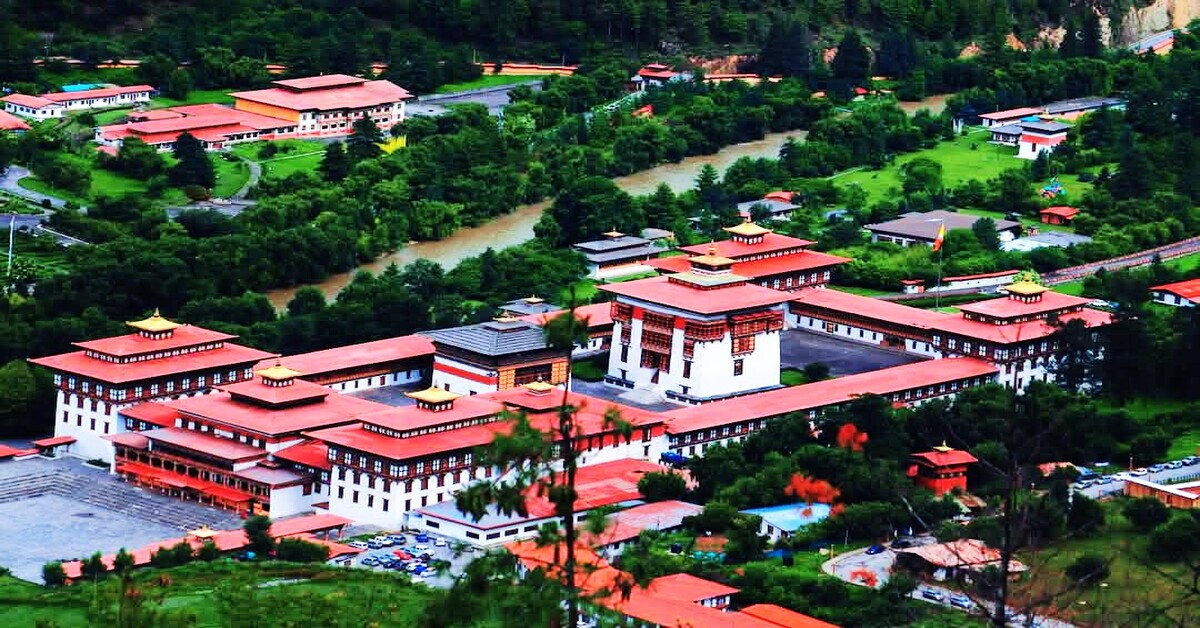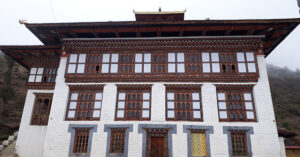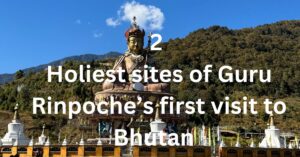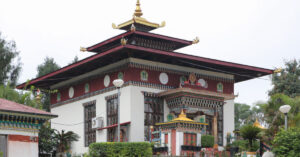Tashichho Dzong, also known as Thimphu Dzong, is one of the 16 dzongs built by Zhabdrung Ngawang Namgyal in Bhutan in 1641. The dzong is situated north of Thimphu town, on the west bank of the Wang Chhu River.
In 1962, Tashichho Dzong, the “Fortress of the Glorious Religion,” replaced Punakha Dzong as the center of Bhutan’s capital. Thimphu Dzong houses the king’s throne room and offices and serves as the summer residence of the central monastic body.
Thimphu Dzong is one of Bhutan’s most popular tourist attractions during the autumn Thimphu Tshechu Festival.
How to Reach Tashichho Dzong
Tashichho Dzong is situated to the north of Thimphu city. A cab can be hired from any part of Thimphu town to reach the Dzong. You can visit the fortress only after 5 PM when the government offices close for the day. However, the fortress is open from 11 AM to 4 PM during government holidays. The Tashichho Dzong entry fee is Nu. 500, but children under 5 years old are free.
Also Read: Wangdue Phodrang Dzong, the Fortress of Glorious Unification
Sacred Relics to See at Thimphu Dzong
- The funeral chorten of the 69th Je Khenpo on the 3rd floor;
- The toilet of the Zhabdrung in his former living room;
- A small temple, Lhakhang Sarp, whose beams are supported by mythological creatures;
- The Dukhang houses a large statue of Sakyamuni Buddha and the thrones of the King and Je Khenpo.
Also Read: Guru Rinpoche in Bhutan: His Visits to Bhutan and Sacred Sites
History of Tashichho Dzong
The Dzong was first built in 1216 by Lama Gyalwa Lhanapa Sanggye Rinchen, where Dechen Phodrang Monastery now stands. It was named Do-ngon Dzong or Blue Stone Dzong. However, in the 13th century, it was taken over as the seat of Phajo Drugom Zhigpo.
In 1641, the descendants of Phajo offered Do-ngon Dzong to Zhabdrung Ngawang Namgyal. So, why was Tashichho Dzong built? Since Do-ngon Dzong or Blue Stone Dzong was small, he built a new dzong lower down in the valley and named it Tashi Choe Dzong, the “Fortress of Auspicious Doctrine” to spread the Drukpa Kargyu.
Later, Gyalsey Tenzin Rabgye, the fourth Desi, built a new monastic assembly hall at Tashichoe Dzong. However, a fire destroyed the Dzong. The fifth Desi, Gendun Chophel, oversaw the reconstruction process until its completion in 1698.
The old Dzong was destroyed by fire in 1772. Sonam Lhundrup, the 16th Desi, constructed a new Dzong at the current location and named it Sonamcho-Dzong. Once again, the fortress was renamed Tashicho-Dzong after the Desi’s death.
In 1777, the 18th Desi, Jigme Singye, remodified the interior of the Dzong’s Kunrey since it was dark. The 25th Desi, Pema Cheda, made additional renovations in 1807. Later, Phurgyal, the 32nd Desi, added the Ditsang Lhakhang and installed many new statues in 1826. The Dzong again suffered a devastating fire in 1866 and a deadly earthquake in 1897.
The Third King Jigme Dorji Wangchuck extended and renovated the Dzong to accommodate governmental offices when the capital was moved from Punakha to Thimphu in 1962. Only the Goenkhang, Utse, and Lhakhang Sarp were retained from the old Dzong. The 66th Je Khenpo Yonten Tharchen consecrated it in 1969.
Also Read: Zhemgang Dzong, the Symbol of Unification of Khengrig Namsum
Significance of Tashichho Dzong
Tashichho Dzong, meaning “Fortress of the Glorious Religion,” is immensely significant in Bhutan as both a religious and administrative center. It was founded in 1216 by Gyalwa Lhanangpa and later rebuilt and renamed by Zhabdrung Ngawang Namgyal in 1641. The Dzong houses the throne room and offices of the king, along with various government ministries. It also accommodates the religious leader Je Khenpo.
Also Read: Significance of Gasa Dzong, the Fortress that defended against Northern Invasions
Description of Tashichho Dzong Complex
The fortress of Tashichho Dzong is a majestic complex surrounded by beautiful rose gardens and lush lawns. The complex is whitewashed and has a two-story main building with three-story towers at each of the four corners, each with a triple-tiered golden roof.
There are two entrances to the Dzong. The southern entrance is for the administrative section, which is restricted to visitors. The northern entrance leads to the monastic section, which houses the summer residence of the Je Khenpo and the central monk body. Here, the visitors are greeted by the paintings of the four guardian kings. On either side of the steps are the images of Drukpa Kunley, Thangthong Gyalpo, and Phajo Drugom Zhigpo.
Once inside, there is a Utse accessed via a steep wooden stairway, the funeral chorten of the 69th Je Khenpo on the 3rd floor, and the toilet of the Zhabdrung in his former living room.
In the courtyard nearby lies a small temple, Lhakhang Sarp, whose beams are supported by mythological creatures. The Dukhang houses a large statue of Sakyamuni Buddha and the thrones of the King and Je Khenpo.
To the west of the dzong is the small Neykhang Lhakhang, which houses the local guardian deities Dorji Daktshen and Gyenyen Jagpa Melen. However, it is restricted to tourists.
Also Read: Description of Paro Rinpung Dzong, the Fortress on a Heap of Jewels
Thimphu Dromche and Tshechu Festival
The annual Thimphu Dromche festival is held in the courtyard of Tashichho Dzong on the 6th of the 8th month of the Bhutanese calendar.
Five days later, Thimphu Dromche is followed by the three-day Thimphu Tshechu festival. Thimphu Tshechu is held in the large open-air courtyard, Tendrel Thang, from the 10th day of the 8th month of the Bhutanese calendar. It was first introduced by Gaylsey Tenzin Rabgye in 1867. On the last day of the Tshechu, Sangay Tsokhorsum Thongdrol is unfurled and displayed to the public.
Also Read: The Festival of Punakha Dzong, the Palace of Great Bliss on the Heaped Jewel
Best Time to Visit Tashichho Dzong
The best time to visit Tashichho Dzong is in September and October. Time your trip here during the annual festival to immerse yourself in the local culture, experience unique traditions, enjoy vibrant celebrations, and witness lively performances that might not be readily available during regular times. You can visit the major pilgrimage sites of Thimphu with the Bhutan Pilgrimage Package.
Conclusion
Tashichho Dzong, also known as Thimphu Dzong, is a majestic fortress located on the western bank of the Wang Chhu River in Thimphu. It was first constructed in 1216 by Gyalwa Lhanangpa and later rebuilt by Zhabdrung Ngawang Namgyal in 1641. The present structure was renovated under King Jigme Dorji Wangchuck in 1962. Currently, it serves as the seat of the Royal Government of Bhutan, housing the throne room, offices of the king, and various government ministries. It also hosts the popular Thimphu Tshechu festival.
Other Sacred Sites to Explore in Thimphu
Buddha Dordenma: It is a massive golden statue of Buddha Shakyamuni overlooking the Thimphu valley with a serene and spiritual ambiance. The site also houses thousands of smaller Buddha statues and a meditation hall, offering a unique blend of art, devotion, and tranquility.
National Memorial Chorten: Also known as Thimphu Chorten, it is a stupa in Thimphu built in memory of the third Druk Gyalpo, Jigme Dorji Wangchuck, in 1974.
Dechenphu Lhakhang: It is a monastery dedicated to Geynyen Jagpa Melen, a powerful protective deity, located at the northern end of the Thimphu Valley in Bhutan. The Temple was constructed in the 12th century by Dampa, the son of Phajo Drugom Zhigpo.
Pangri Zampa Monastery: It is one of Bhutan’s oldest monasteries, founded in the 16th century by Ngawang Chogyal, located 8 kilometers north of Thimphu on the west bank of the Thimphu River. The monastery now functions as Bhutan’s Royal College of Astrology, where monks study traditional astrology, and the college is responsible for determining dates for important national events.
Cheri Monastery: Also known as Chagri Dorjeden Monastery, it is the first monastery established in Bhutan by Zhabdrung Ngawang Namgyel in 1620. It is located in the Upper Thimphu Valley, about 15 kilometers north of Thimphu city, perched on a hill at an altitude of approximately 2,850 meters above sea level.
Tango Monastery: The Tango Choying Dzong was founded in the 13th century by Phajo Drugom Zhigpo and rebuilt in its current form in 1688 by the Fourth Temporal Ruler, Tenzin Rabgye. The monastery is perched on a forested hillside near Cheri Mountain, famed for its spiritual legends, particularly the prophecy involving the deity Hayagriva.
Tshelung Ney: Renowned as the “Second Draphu Maratika,” it is a sacred place of prophetic longevity where Guru Rinpoche received life empowerment (Tse Ngedrup) from Tsepakme (Amitayus) during the 8th century while meditating here for four months.
Thuji Dra Monastery: Also known as the Cliff of Compassion, it is one of the four cliffs prophesied by Guru Rinpoche to Phajo Drugom Zhigpo. The Thujidra Temple is located at an altitude of nearly 4,000 meters, where Phajo saw in a vision Phagpa Thujechenpo while meditating here.
Domendrel Tsho: It is a sacred lake located near the site where Gyalse Tenzin Rabgye offered mandala offerings to consecrate the Palace of Sikkim’s King Chador Namgyal in the 17th century. The hike to Domendrel Tsho starts from the base of Tango Monastery, and typically takes 4-5 hours.
Domtsang Ney: It is a sacred meditative cave where Guru Rinpoche meditated in the 8th century. Known as “Bear’s Den,” it’s a revered pilgrimage site that features holy relics like his footprint, a stone bell, and a self-emanated syllable Ah.
Jagar Damkelsa Ney: It is a sacred cliff where the 13th-century Mahasiddha Drubthob Nagi Rinchen meditated to save his mother from hell. The site features a historic bamboo basket and wooden beam, symbolizing his miraculous meditation, making it an important yet lesser-known pilgrimage destination.
Frequently Asked Questions
When was Tashichho Dzong built?
Tashichho Dzong was originally constructed in 1216. However, it was relocated and reconstructed in 1641 by Zhabdrung.
Why was Tashichho Dzong built?
Tashichho Dzong was built initially as a religious fortress to promote and protect Buddhism in Bhutan and later evolved into the central administrative and governmental seat of the country, symbolizing both spiritual and temporal authority.
Enjoyed reading this blog?




